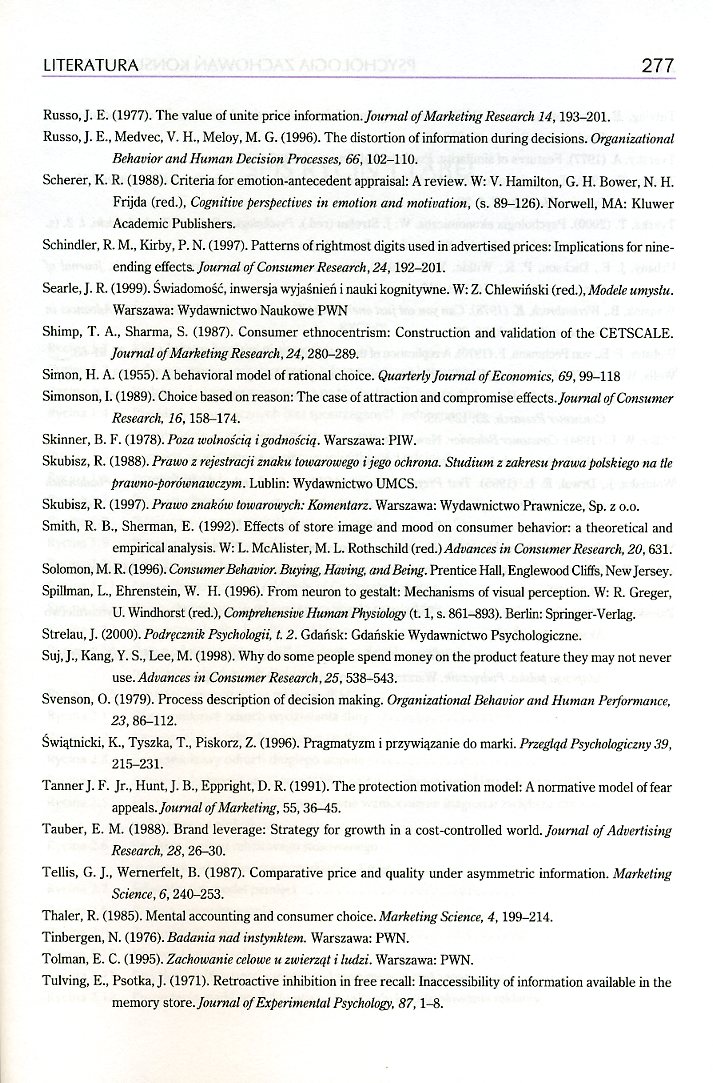PZK277

277
LITERATURA
Russo, J. E. (1977). The value of unitę price information./nwm#/ ofMarketing Research 14,193-201.
Russo, J. E., Medvec, V. H.. Meloy, M. G. (1996). The distortion of information during decisions. Organizational Behaoiorand Humań Decision Processes, 66, 102-110.
Scherer, K. R. (1988). Criteria for emotion-antecedent appraisal: A review. W: V. Hamilton, G. H. Bower, N. H.
Frijda (red.), Cognitiue perspectiues in emotion and motiuation, (s. 89-126). Norwell, MA: Kluwer Academic Publishers.
Schindler, R. M., Kirby, P. N. (1997). Patterns of rightmost digits used in advertised prices: Implications for nine-ending effects. Journal ofCotisumer Research, 24,192-201.
SearleJ. R. (1999). Świadomość, inwersja wyjaśnień i nauki kognitywne. W: Z. Chlewiński (red.), Modele umysłu. Warszawa: Wydawnictwo Naukowe PWN
Shimp, T. A., Sharma, S. (1987). Consumer ethnocentrism: Construction and validation of the CETSCALE. Journal of Marketing Research, 24,280-289.
Simon, H. A. (1955). A behavioral model of rational choice. Quarterly Journal of Economics, 69,99-118
Simonson, I. (1989). Choice based on reason: The case of attraction and compromise effect s. Journal of Consumer Research, 16,158-174.
Skinner, B. F. (1978). Poza wolnością i godnością. Warszawa: PIW.
Skubisz, R. (1988). Prawo z rejestracji znaku towarowego i jego ochrom. Studium z zakresu prawa polskiego na tle prawno-porównawczym. Lublin: Wydawnictwo UMCS.
Skubisz, R. (1997). Prawo znaków towaroioych: Komentarz. Warszawa: Wydawnictwo Prawnicze, Sp, z o.o.
Smith, R. B., Sherman, E. (1992). Effects of storę image and mood on consumer behavior: a theoretical and empirical analysis. W: L. McAlister, M. L. Rothschild (red .)Advances in Consumer Research, 20,631.
Solomon, M. R. (1996). Consumer Behaoior. Buying, Hamng, andBeing. Prentice Hall, Englewood Cliffs, New Jersey.
Spillman, L, Ehrenstein, W. H. (1996). From neuron to gestalt: Mechanisms of visual perception. W: R. Greger, U. Windhorst (red.), Comprehensioe Humań Physiology (t. 1, s. 861-893). Berlin: Springer-Verlag.
Strelau, J. (2000). Podręcznik Psychologii, t. 2. Gdańsk: Gdańskie Wydawnictwo Psychologiczne.
Suj, J., Kang, Y. S., Lee, M. (1998). Why do some people spend money on the product feature they may not never use. Aduances in Consumer Research, 25,538-543.
Svenson, O. (1979). Process description of decision making. Organizational Behauior and Humań Performance, 23,86-112.
Świątnicki, K., Tyszka, T., Piskorz, Z. (1996). Pragmatyzm i przywiązanie do marki. Przegląd Psychologiczny 39, 215-231.
Tanner J. F. Jr., Hunt, J. B., Eppright, D. R. (1991). The protection motivation model: A normative model of fear appeals./rtimM/ of Marketing, 55,36-45.
Tauber, E. M. (1988). Brand leverage: Strategy for growth in a cost-controlled world. Jotmuil of Adoertising Research, 28,26-30.
Tellis, G. J., Wemerfelt, B. (1987). Comparative price and quality under asymmetric information. Marketing Science, 6,240-253.
Thaler, R. (1985). Mental accounting and consumer choice. Marketing Science, 4,199-214.
Tinbergen, N. (1976). Badania nad instynktem. Warszawa: PWN.
Tolman, E. C. (1995). Zachowanie celowe u zwierząt i ludzi. Warszawa: PWN.
Tulving, E., Psotka, J. (1971). Retroactive inhibition in free recall: Inaccessibility of information available in the memory storę. Journal of Experimenlal Psychology, 87,1-8.
Wyszukiwarka
Podobne podstrony:
00219 a6d333666646e915e39fbc117115f5 221 Applications of the EWMA The Control Algorithm In this al
70. A.69057 ECONOMIST on Wall Street : notes on the sanctity of gold, the value of
Sample Lab Reportpago 1Boa Awesome Partners Marie Curie. AJbert Einstein January 1. 2020 Finding the
133 thousand zlotys per hectarc) and the value of fixcd assets (1385 zlotys per hcctarc). The va!uc
2. 2. 3. www.mtuexam.blogspot.in 10 W/m2.K. Calculate the value of highcst current that may bc passe
1972 Nations Unieś — Recueil des Traites 97 (ix) the tax on the value of vacant lots; (hereinaf
DSC06054 (2) 50 Stanisława Golinowska, Piotr Broda- Wysocki Gi łlies P. (1997), Sociał Capital: Reco
THE VALUE OF AN IDEA UCl •* łMt *JUHC O# IT
What is the value of a single "like" in Facebook7 ^ Oznacz zdjęcie 9 Dodaj lokalizację / E
THE PROBLEMS OF QUALIFYING THE VALUE OF REAL ESTATE WITH THE METHOD OF THE STATISTICAL ANALYSIS
autostretching0245 OTHER WRITINGS ABOUT THE VALUE OF STRETCHING The knowledge that some muscle group
2X IDENTIFYING RESISTOR VALUES Use the following information as a guide in properly identifying the
Build Navigator Guidance with through the steps of preparing aactical Information navigat V »
TRESC CONTENTS 269 A r t i c 1 e s ANNA MACHALSKA-GARBACZ: The problems of library and information s
więcej podobnych podstron